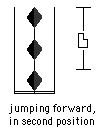

| Direction of travel for a jump is shown by symbols for the landing (this works when you land on one foot or in a closed position). |   |
| A path sign shows direction when you travel in open positions (and may also be used for closed positions) | 
|
| Timing for jumps is based on relative lengths for preparation, "air time" and landing. A greater amount of space between preparation and landing will mean you spend more time in the air, and will usually require greater height for your jump. Compare: |   |
|
Notating jumps is based on a separation of actions that are weightbearing and those that are not. The simplest way to show a jump is to have no symbols in the support columns.No support (on the feet or other body parts) means you are in the air. |
 
|
|
A jump may also be shown by symbols in the columns for leg "gestures." Because these columns are defined as non-weightbearing, gestures for both legs can also indicate a jump (no weight on the legs means you are in the air, as long as there are no other body parts supporting). This method is used to cancel a pause, and when there is a turn in the air.
Action lines are usually used to substitute for direction symbols when the particular leg gestures are unimportant (when your attention is just on going in the air).
|
  |
|
The method of notating jumping, through meanings inherent in the staff columns rather than a specific set of symbols, is indicative of the context-based theory of the Labanotation system. Symbols gain meaning based on their relationships to the staff and other symbols. As with steps, the method of notating jumping simplifies a physically complex sequence of movements in order minimize signs for what is understood to be a common action (see steps: history note). Full analysis of the various joint actions is possible but usually unnecessary. Instead, attention is often given to the gestures of the legs during the jumps (see gestures section). |